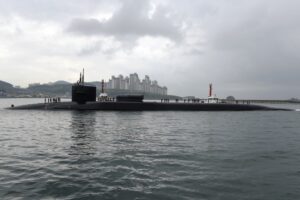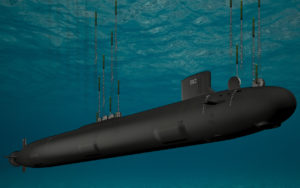A top Navy official said the service plans to deploy the first conventional hypersonic weapons on Ohio-class submarines by 2025 before adding them to newer Virginia-class vessels starting in 2028.
The weapons, called Conventional Prompt Strike (CPS) capability, are scheduled to be deployed first to the Army by around 2023 and then to the Navy on its four-vessel group of Ohio-class non-nuclear weapon armed guided-missile submarines (SSGNs) by around 2025, Vice Adm. Johnny Wolfe, director of Strategic Systems programs, said during the annual virtual Naval Submarine League symposium on Nov. 17.

Then, later, CPS is planned to be deployed on Block V Virginia-class attack submarines equipped with the Virginia Payload Module (VPM) starting in 2028. The VPM-equipped vessels increase the submarine’s missile capacity by adding 28 more missile tubes, allowing for up to 40 total missiles per vessel. They are meant to, in part, replace the missile capacity of the four SSGNs that each carry up to 154 missiles, once they retire at the end of their service lives.
Wolfe underscored CPS overall is “very much a priority, within the Navy it is very much a priority.”
“We are really focused on how do we get a rapid developed program to take all the successes that we’ve had in the research and development of flight testing and how do we start to productionize that and how do we transition that into a military capability that we can give to the Army…for their first all up round capability in about the 2023 timeframe. And how do we continue to push that forward so that we get to a Navy capability on SSGN in the 2025 timeframe.”
Wolfe noted earlier in the year the Army and Navy jointly conducted a launch of the Common Hypersonic Glide Body (C-HGB) from the Pacific Missile Range Facility in Hawaii, where the system flew at a hypersonic speed to reach its designated impact point (Defense Daily, March 20).
He said it was “extremely successful, met every single test requirement that we had. It exceeded every single one of those that we had laid in as what we would consider success criteria and that really was the springboard for us to now start that transition out of our national team into industry for a capability that we can produce.”
The C-HGB is being designed by the Navy but the Army will oversee production. The Navy expects to buy a common missile stack rocket booster to lift the glide body to the edge of space, with the two parts combined making up the all-up round. The all-up round will be shared by the Army and Navy. The Army plans to use a transporter erector launcher (TEL) while the Navy will launch the missiles from its vessels. Separately, the Air Force plans to use the same glide body itself but a different launching system.

Wolfe said DoD is not focusing on transitioning the national team work into industry production.
“We are in the throes, this year, of finishing up the development of the booster that that glide body will go on. Again, common booster and common glide body between the Army and the Navy. We are working to finish that development…as we get into static fires and then eventually, we’ll do flight testing from land and then ultimately get to that first SSGN and we are starting to really put meat on the bones of how we integrate this all up round to both within the Army TEL and with the Navy’s SSGNs.”
He acknowledged the program has a “very, very compressed timeline, but I would tell you is we have stayed on schedule, we have continued to push the teams, we’ve continued to push industry and it is all hands on deck and we’re having very, very good success in everything that we’re doing in that program.”
When asked what is the biggest risk to the CPS timeline, Wolfe said the next big thing will be getting industry to reliably meet the production needs.
“I really think it is just getting the industrial base capacity where it needs to be for us to meet all of those various assets. I think we understand the technology, we’ve proven that in flight, we’ve proven that in the things we do.”
“It really is transitioning to production, which we all know with any development program that anybody’s ever dealt with – the science is great, you go off and build one-offs, but then transitioning that to a very repeatable process so you get the reliability that you need and that’s exactly where we’re at right now: transition to production, get industry to staff up to be able to reliably do that and get to the throughput that we need,” Wolfe continued.
The government has also been flirting with the idea of basing hypersonic weapons for surface vessels, but Wolfe did not comment on that possibility
The House Armed Services Committee’s mark for the FY 2021 defense authorization bill includes a provision directing the Navy to start integrating a hypersonic missile onto the three Zumwalt-class guided-missile destroyer by January 2021 (Defense Daily, June 21).
Then, last month, National Security Adviser Robert O’Brien said the CPS capability will first be deployed on the newer Virginia-class submarines and the Zumwalt-class destroyers but “eventually, all three flights of the Arleigh Burke-class destroyers will field this capability,” (Defense Daily, Oct. 22).
According to the Navy’s FY ’21 budget request documents, the service is pursuing an Initial Operational Capability of deploying the hypersonic weapons on a Virginia-class VPM-equipped submarine in FY 2028.
The documents also said the Navy aims to develop a system deployable from both surface and submerged platforms.